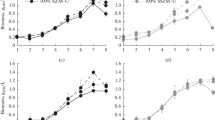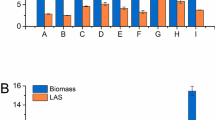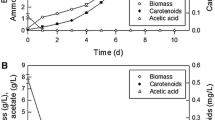Abstract
Various Spirulina strains were assayed for their productivity of γ-linolenic acid (γLnn). Spirulina platensis ARM-346 was found to accumulate large amounts of γLnn. Urea as a nitrogen source was found to be most effective giving a yield of 13.5 mg γLnn/g dry cell mass. With increase in temperature the γLnn content was found to increase along with biomass. The optimum temperature for maximum γLnn and biomass production was found to be 35°C. The γLnn content was highest at 0.06% (w/v) NaCl and 0.07% (w/v) K2HPO4. Cells cultivated in the orange region of the electromagnetic spectrum as energy source showed a high content of γLnn, and there was less biomass compared to cells grown in red light. When the culture was left in the dark for various times, after 144 h it contained about 26% more γLnn than in conventionally cultivated cells.
Similar content being viewed by others
References
Begin ME, Das UN (1986) A deficiency in dietary gamma-linolenic acid or eicosapentaenoic acids may determine individual susceptivility to A.I.D.S. Med Hypotheses 20:1–8
Cobelas MA (1989) Lipids in microalgae. A review. II. Grasas Y Aceites 40(3):213–223
Cohen Z, Vonshak A, Richmond A (1987) Fatty acid composition of Spirulina strains grown under various environmental conditions. Phytochemistry 26–8:2255–2258
Hirano M, Mori H, Miura Y, Matsunaga, Nakamura N, Matsunaga T (1990) γ-Linolenic acid production by microalgae. Appl Microbiol Biotechnol 24/25:183–191
James P, Carter MD (1988) Gamma linolenic acids as a nutrient. Food Technol 42:72–82
Lindberg AM, Hansson L (1991) Production of γ-linolenic acid by fungus Mucor rouxii on cheap nitrogen and carbon sources. Appl Microbiol Biotechnol 36:26–28
Lynch DV, Thompson GA (1984) Microsomal phospholipid molecular species alternation during low temperature acclimation in Dunaliella. Plant Physiol 74:193–197
Pohl P (1974) Control of unsaturated fatty acid biosynthesis in unicellular algae by the nitrogen content of the nutrient medium and by the wave length of light. J Am Oil Chemists Soc 51:521A
Tomaselli L, Giovannetti L, Sacchi A, Bocci F (1988) Effects of temperature on growth and biomechemical composition in Spirulina platensis strain M2. Algal Biotechnol:305–314
Venkataraman LV (1993) Spirulina in India. In: Proceedings of the National Seminar on Cyanobacter Research — The Indian scene. National Facility for Marine Cyanobacteria, Bharathidasan University, Tiruchirapalli, pp 92–116
Author information
Authors and Affiliations
Rights and permissions
About this article
Cite this article
Mahajan, G., Kamat, M. γ-Linolenic acid production from Spirulina platensis . Appl Microbiol Biotechnol 43, 466–469 (1995). https://doi.org/10.1007/BF00218450
Received:
Accepted:
Issue Date:
DOI: https://doi.org/10.1007/BF00218450




